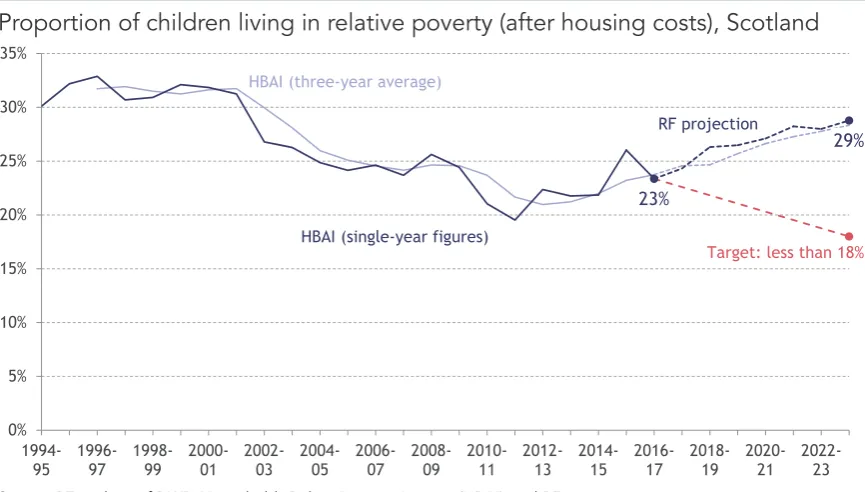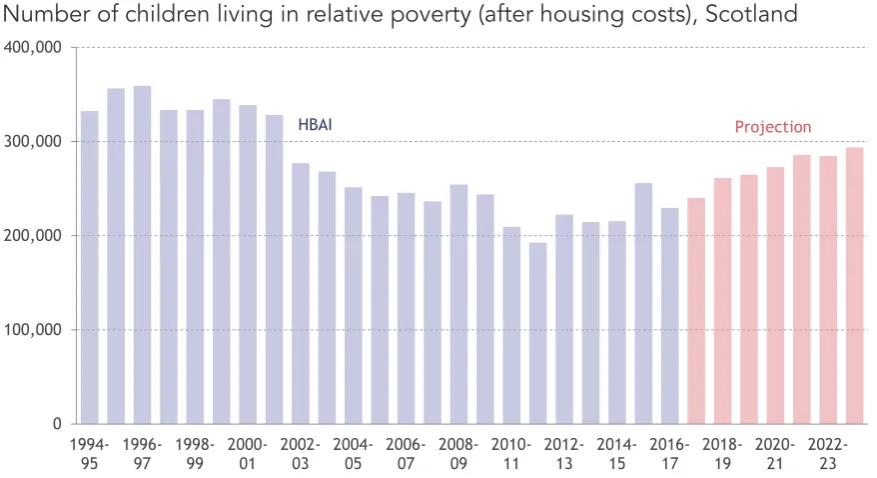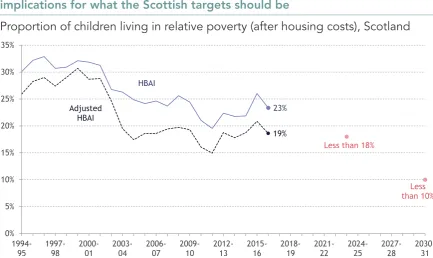BRIEFING
info@resolutionfoundation.org +44 (0)203 372 2960 @resfoundation resolutionfoundation.org
Wrong direction
Can Scotland hit its child poverty targets?
Download
This document is available to download as a free PDF at: https://www.resolutionfoundation.org/publications
Citation
If you are using this document in your own writing, our preferred citation is:
A Corlett, Wrong direction: Can Scotland hit its child poverty targets?, Resolution Foundation, March 2019
Permission to share
This document is published under the Creative Commons Attribution Non Commercial No Derivatives 3.0 England and Wales Licence. This allows anyone to download, reuse, reprint, distribute, and/or copy Resolution Foundation publications without written permission subject to the conditions set out in the Creative Commons Licence. For commercial use, please contact: info@resolutionfoundation.org
Acknowledgements
The author would like to thank those experts who have shared their thoughts on this report through conversations and comments, in particular Dr Jim McCormick, Associate Director for Scotland at the Joseph Rowntree Foundation. Any errors or omissions are, of course, our own.
3 Can Scotland hit its child poverty targets?
Can Scotland hit its child poverty
targets?
In 2017, Members of the Scottish Parliament unanimously voted the Child Poverty (Scotland) Act 2017 into law, creating targets for the reduction of child poverty. This followed the UK government’s abandoning of its 2020 targets, and marked a welcome attempt to ensure that poverty reduction remained a policy priority north of the border. But agreeing to reduce poverty is easier than doing it. So what are the prospects for the Scottish government hitting its goals?
The Scottish government’s desired destination is clear and
ambitious
Table 1 provides a summary of Scotland’s child poverty targets as specified in the Act. There are four in total, covering relative poverty, absolute poverty, material deprivation and persistent poverty. Each approach has something to offer, and it is likely that different policy interventions will have differing effects on the proportion of children recorded under each measure. But it is the relative poverty target that serves as the headline, and is the focus of this briefing.
Focusing on this measure, we can see that 23 per cent of Scottish children (around 230,000) lived in households that were below the UK relative poverty line in 2016-17.[1]
While significant, that proportion compares favourably to the overall UK figure of 30 per cent. Indeed, Scotland has been the part of the UK with the lowest child poverty rate over the last three years as a whole, reflecting the fact that Scotland enjoys relatively high earnings but without the same degree of housing cost pressure as London (which has the highest rate of child poverty, after housing costs).
Despite this performance, the Scottish government wishes to push the relative poverty rate significantly lower over the coming years. Ultimately, it is aiming to get the
proportion of children living in households with income below 60 per cent of the median under 10 per cent (by 2030-31). The interim target, for 2023-24, requires a relative poverty rate of under 18 per cent.
Table 1: Scotland’s four child poverty targets
Notes: Medians are UK-wide. Household incomes are equivalised, disposable and after housing costs Source: Child Poverty (Scotland) Act 2017
But poverty is heading in the wrong direction
We have no hard data yet on what has happened to child poverty in the short period since the Act was passed. And, while 2017-18 data will be out shortly, it is in any case unwise to draw definitive conclusions from single years of data given the small sample sizes present in household surveys. But what we do know is that child poverty has been heading in the wrong direction in recent years. In keeping with trends elsewhere in the UK, it declined between the mid-1990s and 2011-12, but it has since been on a slight upward trend.
Figure 1: Our poverty projection suggests the 2023 interim target will be missed by a wide margin
Proportion of children living in relative poverty (after housing costs), Scotland
Source: RF analysis of DWP, Households Below Average Income (HBAI), and RF projection
Latest estimate Interim target Final target
2016-17 2023-24 2030-31
Relative poverty (below 60% of median)
23% 18% 10%
Absolute poverty (below 60% of the 2010-11 median)
20% 14% 5%
Combined low income (below 70% of median) and material deprivation
11% 8% 5%
Persistent poverty (below 60% of median in at least 3 of the last 4 years)
10% 8% 5%
Targets (less than)
23%
29%
0% 5% 10% 15% 20% 25% 30% 35%
1994-95 1996-97 1998-99 2000-01 2002-03 2004-05 2006-07 2008-09 2010-11 2012-13 2014-15 2016-17 2018-19 2020-21 2022-23
Target: less than 18%
HBAI (three-year average)
RF projection
5 Can Scotland hit its child poverty targets?
Hitting the 2023-24 interim target therefore requires a change of direction. However, as Figure 1 shows, the Resolution Foundation’s projections suggest that no such change is likely to be forthcoming.[2] In fact, our forecasts - based on current economic forecasts and
policy – point to relative child poverty in Scotland rising to 29 per cent.
If realised, this would be the highest relative poverty rate recorded in Scotland in over two decades. As Figure 2 shows, it would lift the number of children living in poverty from 230,000 in 2016-17 to 290,000 by 2023-24.[3] Such an outcome would leave over 100,000
[image:5.595.77.516.283.522.2]more children living in poverty than if the interim target were (just) met.
Figure 2: Without significant policy changes, the number of Scottish children in poverty is likely to head in the wrong direction
Number of children living in relative poverty (after housing costs), Scotland
Source: RF analysis of DWP, Households Below Average Income (HBAI), and RF projection
Of course, there is a lot of uncertainty about these projections. The Office for Budget Responsibility’s economic forecasts – which underpin many of our assumptions – can change and indeed have been changed marginally since the projections were made.[4]
These changes have not been in a direction that will help Scotland’s poverty figures, but they will undoubtedly change again over the course of the poverty target period. Additional uncertainty stems from the fact that the headline poverty target is set relative to median income in the UK. This means that any significant divergences in earnings, employment or housing costs between Scotland and the rest of the UK could have an important impact, but these are particularly hard to predict.
Our modelling also currently misses some of the Scottish government’s policies: notably the Best Start Grant, the (disability-related) Carer’s Allowance Supplement and more generous Council Tax Support. But, while welcome, these are relatively minor compared
[2] These projections are based on A Corlett, The Living Standards Outlook 2019, Resolution Foundation, February 2019 [3] Note however that we use UK-wide demographic projections.
[4] See Resolution Foundation, Super, smashing, great: Spring Statement 2019 response, March 2019.
0 100,000 200,000 300,000 400,000
1994-95 1996-97 1998-99 2000-01 2002-03 2004-05 2006-07 2008-09 2010-11 2012-13 2014-15 2016-17 2018-19 2020-21 2022-23
to other forces shaping child poverty levels. The Best Start Grant, for example, will only cost £3 million more than the UK-wide grant that it replaces in its first phase (of three), and is expected to have only a small impact on poverty indicators.[5]The fact that our
projection implies not just that the poverty target will be missed, but that the measure is set to head in entirely the wrong direction (as do earlier projections from others[6]),
suggests that very significant policy changes are required.
The direct causes of the expected rise in poverty are UK-wide policies set in place at the 2015 Summer Budget, amounting to an estimated £12 billion cut in working-age benefits once fully rolled out. In particular, the four-year freeze in benefit values has taken large chunks out of state support for parents in 2017-18 and 2018-19, and is set to do so again in 2019-20. The policy is set to save the UK government £1.8 billion from this year’s freeze alone, bringing the total saving in 2019-20 to £4.7 billion – costing couples with children in the bottom fifth of the income distribution £900 on average. Likewise, the two child limit will take up to £2,800 a year per additional child from many families, and the abolition of the ‘family element’ will take up to £545 from each family on tax credits or Universal Credit.
Nevertheless, while it is Westminster rather than Holyrood that explains the current direction of travel, the Scottish government is not powerless. The decisions it takes in the coming years have the potential to make a difference to outcomes for children.
Experience certainly suggests that giving cash to parents of dependent children –
recognising through social security people’s relatively high income requirements at that stage of life – is an effective way to meet child poverty targets, if the political will is there. This can be seen in the example of the UK-wide experience during the 2000s;[7] new data
from Canada about the impact of Canada Child Benefit and other policies;[8] a recent
report on how to slash child poverty in the US;[9] and New Zealand’s first steps towards
meeting child poverty goals.[10]
With this in mind, the Scottish government’s proposed new ‘Income Supplement’ could play an important role. The payment is due to be introduced by 2022, with a specific focus on reducing child poverty. However, the government has not yet provided any details of how it will work. At this point we don’t know who will receive it; whether it will be £5,000, £500 or £5 a year; when exactly it will start reaching people; or how it will be paid for. Other options include the lifting of the value of child benefit, with the Child Poverty Action Group recommending a £5 a week increase as a less targeted but simpler approach to poverty alleviation for example.[11] It is also possible that replacing the current
regressive system of council tax, as cross-party talks are set to discuss,[12] could help
reduce child poverty, if done right.
[5] See Scottish Fiscal Commission, Expenditure forecast on first part of Scotland’s new Best Start Grant, September 2018; and gov.scot, Best Start Grant: Fairer Scotland Duty assessment, January 2019
[6] See H Reed & G Stark, Forecasting Child Poverty in Scotland: A report for the Scottish Government, April 2018; and A Hood & T Waters, Living standards, poverty and inequality in the UK: 2017–18 to 2021–22, IFS, November 2017
[7] A Corlett, S Clarke, C D’Arcy & J Wood, The Living Standards Audit 2018, Resolution Foundation, July 2018 [8] Statistics Canada, Canadian Income Survey, 2017, February 2019
[9] National Academies of Sciences, Engineering, and Medicine, A Roadmap to Reducing Child Poverty, The National Academies Press, 2019
[10] See https://www.ird.govt.nz/news-updates/families-package-bill.html
7 Can Scotland hit its child poverty targets?
And the government’s targets might be undermined by a faulty
navigation system
While reducing child poverty is the big challenge, it turns out that measuring it accurately is also difficult. This raises the possibility that we might not know for sure whether Scotland hits its targets or not. Second, those targets are themselves based on unsatisfactory data.
Child poverty is measured through household surveys. But these may be inaccurate if people do not answer the (often detailed and very numerous) questions correctly. Our analysis has suggested that across Britain around £40 billion a year of benefit income is missing from these surveys.[13] This is enough to significantly distort poverty statistics.
We have modelled what poverty statistics might look like if all of this income was
[image:7.595.78.512.450.708.2]accounted for, with important implications. For one, it is likely that current poverty rates are overestimates. Our rough adjustment – set out in Figure 3 – would suggest that the true rate of Scottish child poverty is 19 per cent, rather than 23 per cent. Importantly however, the stats are also likely to underestimate changes in poverty. Looking at the period from 1999-00 to 2004-05, when child poverty was the focus of significant policy attention (and funding), it may be that Scottish rates fell by 13 percentage points rather than the 7 percentage points recorded in the official data. Child poverty may even have dropped as low as 15 per cent in 2011-12.
Figure 3: Child poverty data may well be revised in the coming years, with implications for what the Scottish targets should be
Proportion of children living in relative poverty (after housing costs), Scotland
Notes: The ‘adjusted HBAI’ series should only be taken as a very rough indicator of how the data might be revised in future Source: RF analysis of DWP, Households Below Average Income (HBAI), and RF adjustment from The Living Standards Audit 2018
[13] A Corlett, S Clarke, C D’Arcy & J Wood, The Living Standards Audit 2018, Resolution Foundation, July 2018
23%
19%
0% 5% 10% 15% 20% 25% 30% 35%
1994-95 1997-98 2000-01 2003-04 2006-07 2009-10 2012-13 2015-16 2018-19 2021-22 2024-25 2027-28 2030-31
HBAI
Adjusted HBAI
Less than 18%
This has implications for the Scottish government’s targets. Indeed, it might even be that all that is needed to hit the target of reducing child poverty below 18 per cent by 2023-24 is to get the existing measurement right (something which the Department for Work and Pensions (DWP) and the Office for National Statistics (ONS) might seek to do via more active use of administrative benefits data). While that approach would no doubt be cheaper than actually reducing child poverty it would clearly not be in the spirit of the Act or the intentions of the Scottish government or parliament. Instead, it is more likely that the targets would need updating if or when better outturn data became available.
Measuring incomes and poverty correctly matters not just for determining the targets, but also for properly assessing the impact of new policies. What should be particularly worrying for the Scottish government is that new social security programs may be especially likely to be misreported in survey data. For example, around a third of the spending associated with the introduction of Child and Working Tax Credits seems to have gone unrecorded in the survey data. It is this which drives the very marked divergence in the official and adjusted poverty trends in this period set out in Figure 3. New (and Scotland-specific) benefits such as the Income Supplement and non-annual Best Start Grants risk similarly confusing survey respondents. Of course, this is not a good reason not to introduce such benefits, but it is an extra reason why methodological improvements are urgently needed if levels and trends are to be recorded correctly.
Moving things in the right direction requires a more radical
programme of social security reform
The Scottish government and parliament should be applauded for reviving child poverty goals. But setting a goal is very different from achieving it. As things stand, in Scotland – as in the UK as a whole – relative child poverty is very likely to go up rather than down. Politicians across the UK have options available to them to start turning this worrying trend around, but only if they are prepared to back warm words with concrete action and, crucially, funding. Reversing at least some elements of the UK-wide social security cuts announced in 2015 comes with a price tag. So too does the introduction of new policies in Scotland designed to provide new support for lower income households. The new Income Supplement could help to reduce, or at least limit rises in, child poverty for example: but only if it is sufficiently ambitious and adequately resourced.
info@resolutionfoundation.org +44 (0)203 372 2960 @resfoundation resolutionfoundation.org


